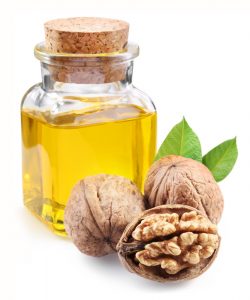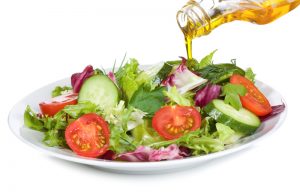What’s the Healthiest Oil? The Winner Is…
Liquid vegetables oils—for example, olive oil and soybean oil—are celebrated as healthy unsaturated fats. Unsaturated fatty acids, when substituted for saturated fats, support general heart health. But for cooking, baking, or dressing salads, what is the healthiest cooking oil?
Many people would probably give the answer that olive oil is the healthiest cooking oil. This cornerstone of the Mediterranean eating pattern has been showered with positive press in recent years. However, most liquid plant oils, with the exception of certain tropical oils like coconut and palm oils, have more in common than not—if you take a wide-angle view.
Beyond the hype about the health benefits of particular dietary fats, there isn’t much solid science to justify touting one specific oil as the healthiest cooking oil. Instead, let your taste preferences and food budget be your guide and try to use a variety of oils.

Walnuts are a worthy source of alpha-linolenic acid (ALA), an important omega-3 fatty acid. As such, walnut oil has become a popular type of oil for flavoring, as the USDA notes.
Healthiest Oil for Your Diet
The spectrum of liquid vegetable oils includes avocado, canola, corn, olive, peanut, pumpkin seed, safflower, sesame, soybean, sunflower, and walnut oil. Each contains lots of monounsaturated fatty acids and polyunsaturated fatty acids, and each remains a liquid at room temperature.
According to the 2015–2020 Dietary Guidelines for Americans, oils contribute to a healthy eating pattern because they are a rich source of essential omega-3 and omega-6 fatty acids. They’re called “essential” because your body can’t make them on its own, yet they’re necessary for good nutrition.
Oils are also an important source of vitamin E, an essential vitamin that acts as an antioxidant. This protective chemical neutralizes the free radicals formed during normal cell activity. Common causes of exposure to free radicals in the environment include cigarette smoke, air pollution, and ultraviolet light from the sun.
Fatty Acids and Oils
More than 20 types of individual fatty acids are found in food oils—and not just vegetable oils. Seafood and nuts also contain significant amounts of essential fatty acids. Vegetable and other oils vary by the amounts of saturated and unsaturated fats they contain:
- Polyunsaturated fats are most abundant in corn, cottonseed, flax, pumpkin, pine nut, sesame, soybean, sunflower, and walnut oils.
- Monounsaturated fats exist in the highest percentages in avocado, canola, olive, peanut, sunflower, and safflower oils.
- Tropical oils contain comparatively few monounsaturated or polyunsaturated fats. Palm kernel oil is about 85 percent saturated fat and coconut oil is more than 90 percent saturated fat. (Although coconut and palm oils are semi-solid at room temperature, they are considered vegetable oils.)
Oils and Heart Health
Of all these, which is the healthiest cooking oil? First, you need to decide what you mean by “healthy.” Some of the biggest and best studies have focused on heart disease—a leading cause of diet-related illness and death in developed countries. More than 17 million people die of cardiovascular disease globally. (See also What Is Cardiovascular Disease? It’s Actually Dozens of Disorders.)
SOURCES & RESOURCE
For related reading, please visit these posts:
Research to date points to polyunsaturated fats as an important factor in why plant-rich eating patterns are heart-healthy. Polyunsaturated fats include the two essential fatty acids your body can’t make on its own: alpha-linolenic acid (an omega-3 fatty acid) and linoleic acid (an omega-6 fatty acid). The body can transform these two “parent” fatty acids into the other ones you need for adequate nutrition.
In June 2017, an advisory panel to the American Heart Association published a report in the journal Circulation on dietary fats and cardiovascular disease. It came to several key conclusions:
- Randomized controlled trials to date show that reducing your intake of saturated fats and replacing them with polyunsaturated fats lowers the chance of cardiovascular disease by about 30 percent—roughly the same effect as taking a cholesterol-lowering statin drug.
- Long-term observational studies have shown that people who eat less saturated fats and more mono- and polyunsaturated fats are less likely to have cardiovascular disease and have a lower risk of death from heart diseases and other causes.
- Replacing saturated fats with unsaturated fats lowers “bad” LDL cholesterol, a cause of coronary artery disease (narrowed arteries to the heart). Replacement with monounsaturated fats accounts for 15 percent of the lower risk, while substitution with polyunsaturated fats brings 25 percent less risk.
“Both polyunsaturated fats and monounsaturated fats are effective in reducing cardiovascular disease,” the panel wrote in its report. “The effect is greatest for polyunsaturated fats.”
Healthiest Cooking Oil? And the Winners Are…
Based on the AHA panel’s conclusions, it sounds like an obvious choice: Oils that have the most polyunsaturated fats, like corn and soybean, appear to be the healthiest cooking oil overall because they have the most benefit for heart health. But that’s not the real message. The panel’s work echoes what you’ve been hearing for years: All other factors in your diet being equal, the type of fats you consume—not the total amount of them—is the most important thing. So there is no single oil to anoint as “the winner.” The answer instead involves different types of oils and how we consume them:
- Replace some of your saturated fats from animal foods with unsaturated fats from plant oils; that practice, per research, appears to promote health.
- Remember that monounsaturated fats are still associated with good health, so olive oil consumption—relative to saturated fat intake—is beneficial.
- Try to consume a variety of oils based on your taste preferences and food budget. For example, go ahead and try some fancy extra-virgin olive or pumpkin seed oil for drizzling on salads, but corn or canola are still healthy options for general use.
Regarding the latter point, eating a variety of oils broadens the portfolio of fatty acids in your diet along with the benefits that different ones may offer. In combination with fish and nut consumption, you’ll get what you need without having to micromanage your fatty acid intake.
Tropical plant oils are the exception to the rule. Palm kernel and coconut oil are high in saturated fat, so replacing animal fats with those options doesn’t make much sense.
All other things being equal, the bottom line is that it’s best to favor oils that primarily contain monounsaturated and polyunsaturated fatty acids.
DON’T FEAR THE FAT: A COMMON-SENSE APPROACH TO VEGETABLE OILS
Oils are relatively calorie-dense. Vegetable oils contain about 120 calories and 14 grams of fat per tablespoon. But push the pause button for a moment about fats and calories—a much-misunderstood concept in healthy eating.
Before nutrition guidelines shifted focus from total fats to types of fats, a lot of people became fat-phobic. Health writers often still warn you not to overdo it on the oils, because they are “loaded” with calories.

Oils may add some calories to a salad, but they also have a satiating effect, helping to make us feel “full.”
If you’re overweight and counting calories, vegetable oil intake may be something to be mindful about. But keep in mind we don’t eat our oils by the tablespoon—we eat them as part of meals and overall dietary patterns.
Although oils add calories to meals, they are also more satiating and therefore could help reduce cravings between meals. In combination with dark, leafy greens in salads, oils help the body to absorb fat-soluble nutrients like carotenoids—the pigments that make fruits and vegetables yellow, orange, or red.
Finally, fats add flavor and pleasant “mouth feel” to healthy foods. Consuming nutritious foods that you like—as opposed to ones you think you are supposed to eat for your own good—can help sustain an overall healthy eating pattern.
The post What’s the Healthiest Oil? The Winner Is… appeared first on University Health News.
Read Original Article: What’s the Healthiest Oil? The Winner Is… »

